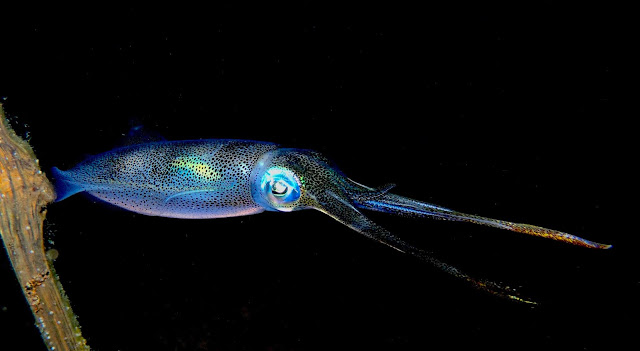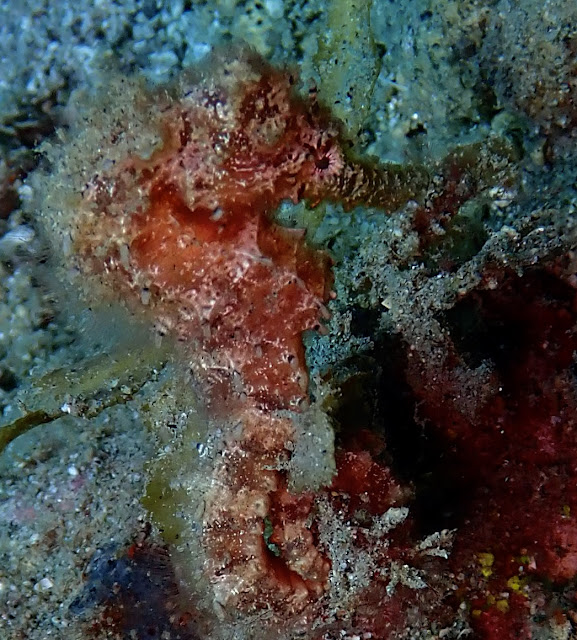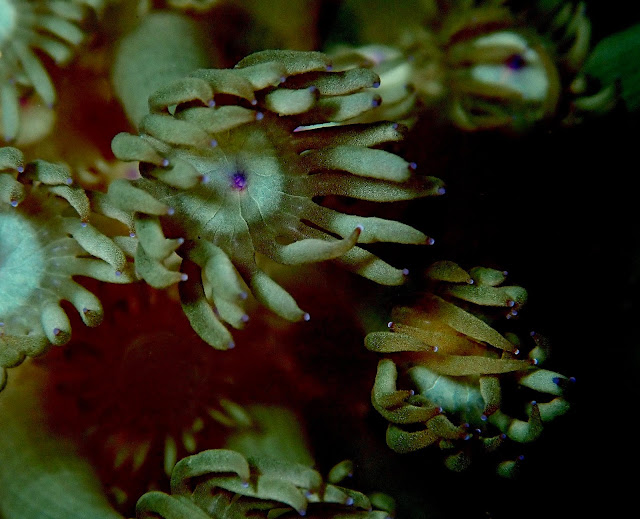On to another lesson in marine life. Cephalopods include Octopus, Squid and Cuttlefish.
The greatest distinction is that Octopus have eight long ‘arms’; but Squid and CuttleFish have eight short arms and two long tentacles, with suckers to attack their prey
Squid vs CuttleFish
Squid
-have torpedo-shaped bodies
-are fast-moving predators
-have flexible feather-shaped structure inside their bodies call the ‘pen’.
-have round pupils
Night dives are cool because you see things out at night that you don’t see during the day light. We did 3 night dives, walking into the water from shore with flashlights, watching Gien to signal if he saw something for us to take photos of. On one of the night dives we saw this Squid
It fits the description and they are electric ! Notice the round pupils.
You can see the tentacles
CuttleFish
-have stout bodies
-are slow, and move by the long fins on the sides of their bodies
-have a broad ‘cuttlebone’ which is really an internal shell that is porous and helps them stay buoyant underwater. The cuttlebones that you see in bird cages provide a calcium supplement
-have W-shaped pupils
-range in size from 6-20 inches
-life expectancy of 1-2 year
-are among the most intelligent invertebrates, with one of the largest brain-to-body-size ratio
-cuttlefish mate face-to-face, isn't that sweet ? Males use a specialized tentacle to insert sperm sacs into an opening near the female's mouth. The male then guards the female until she lays around 200 eggs a few hours later. Sadly they both then die. In 2-5 months the eggs will hatch into independent little CuttleFish
We saw 2 different kinds of CuttleFish, this is the BroadClub CuttleFish
They have the ability to change their color, texture, and shape, much like the Octopus. The common cuttlefish uses 34 different chromatic elements to change their color.
This one was on a different dive. Notice the ‘W’ shaped eyes.
Same day, different dive site. He continued to stare at me, waving tentacles in the air until i left
A short video ... He was mesmerizing ... or .... maybe i was :)
Better watching on UTube: https://youtu.be/KujZ5STpaEg
The Flamboyant CuttleFish
This is one -prized -invertebrate that divers travel great distances to hope to get an opportunity to see. They also have the ability to change color, texture, and shape, much like the other CuttleFish, but the Flamboyant CuttleFish has up to 75 chromatic elements to change their colors ! (not just 34 like the common guys). It truly lives up to it’s name and reputation. It also contains unique acids that make it unsuitable for eating.
Although those Nudibranch were beautiful and interesting, the Flamboyant CuttleFish ‘stole the show’ every time we saw them. And we were lucky enough to see them 4 times. Each time Phil, Oliver (another fun guy that joined our group), and i saw them, we didn’t want to quit watching them. One Flamboyant CuttleFish is cool, but 2 and 3 of them together, interacting was irresistible We could only guess at what they were doing.
This is the first one we saw, and we were so excited ! Notice the W-eye ... and the colors !
These are of the first 3 that we saw. We could only imagine what was going on .... a 3-way orgy ?
They were climbing all over each other, vying for position. You couldn't tell where one started and the other one ended.
With colors constantly changing
A few days later we saw these 2 interacting
As you look at the photos notice how their colors change.
Looking at the photos, you can see all their colors, but it is difficult to get a sense of what they really look like and how they act. Also, the Flamboyant CuttleFish is the only one known to WALK upon the sea floor. Due to the small size of its cuttlebone, it can float only for a short time.
This video will give you a better idea of what they are capable of:
--I suggest you NOT view in full screen, it will make you dizzy
--As you watch, note:
--in the first 4-12 seconds of the video; the one on the right repeatedly sticks his white tentacles out and grabs a snack
--how their colors change; and their color radiates in waves
--how they WALK with two of their outside tentacles
--how their fins are rippling along their body as they propel themselves
This was definitely the highlight ... also because i could actually see them, and watch how they moved. I hope you enjoy this with at least a fraction of my excitement !
You can also go to: https://youtu.be/Rq1N4t31cgc .... the quality might be better
i've been doing a lot of research on CuttleFish and came across this crazy piece of information regarding mating behavior that i've never heard before:
Usually the bigger, stronger male gets the girl, right? However, the female calls the shots and rejects 70% of the males. But there is something else going on. The smaller males actively engage in 'cross-dressing' a like female, acting like females, hiding their male apparatus, and just hanging out. Eventually they see 2 larger makes 'duking it out' or chasing each other. Then the little guy pops in for a bit of CuttleFish Love. The cross-dressers are successful almost 40% of the time ! Not sure what this is doing to the brute strength of the gene pool; but it certainly increases the intelligence of the species :)
Next up are SeaHorses and PipeFish
I think you all know that the Male SeaHorse carries the unborn babies, this is also true for the PipeFish.
Here are some other facts
-- Seahorses swim upright, and propel themselves using a small fin on their back that flutters up to 35 times per second, smaller pectoral fins near the back of the head are used for steering.
In this video, you can see the fin on the back fluttering to move it along
-- Because of their body shape, seahorses are rather inept swimmers, as you can see in the video above. They can easily die of exhaustion if caught in storm-roiled seas. But, they can anchor themselves to sea grass and corals with their prehensile tails
This one is from one of our night dives and you can see the tail holding on to some coral
-- Seahorses have no teeth nor stomach. Food passes through their digestive systems so quickly, they must eat almost constantly on plankton and tiny fish to stay alive
-- They can consume 3,000 or more brine shrimp per day.
--Each eye moves independently, so it can follow the activity of passing sea life without giving its presence away
This is another SeaHorse from the same night dive. There were 3 of them right here together, but the 3rd one was uncooperative
-- Females have a territory of about 1000 sq ft and males have a territory of about 5 sq feet, and their territories overlap
-- Seahorses are monogamous and mate for life, engaging in an eight hour courtship dance which includes spinning around, swimming side by side and changing colours.
-- Before the female can pass the eggs to the male they have to be moving at the same speed in the same movements at the same time.
-- Gestation time varies from 14 days to 4 weeks
-- The male seahorse carries the eggs in his pouch until they hatch, then releases fully formed, miniature seahorses into the water
-- can change color very quickly and match any surroundings in which it finds itself
This one is 'pretty in pink'
PipeFish
The name comes from the fact that they have a pipe-like snout that ends in a toothless mouth with an upward opening
Differences
-- they have a dorsal fin to help them move, but they don’t have the pectoral fin like seahorses
-- not all have a prehensile tail
-- they swim horizontally
Like this one that was about 15" long, swimming, horizontally, across the sand by some ropes. Ropes are a great place to look for critters.
This is a pregnant Reef PipeFish .... i think that is pretty obvious.
This is a Ringed PipeFish ... really striking looking ..
check out that tail !
There are also Pygmy PipeFish ... which are obviously, very small and obviously, very hard to see. This one was from a night dive, and it took me a long time to realize it was 'something' other than a 'worm'. It was about 1/2" long and so skinny. Notice the prehensile tail
During the last day of diving, we saw this Pygmy PipeFish. He was really cool and about 2" long. Look closely and you can see the dorsel fin (middle of back), that they use for locomotion
I was proud to find something on my own. This is a photo i took of what i thought was a Pygmy PipeFish .... amazing photo, in perfect focus ....a piece of yarn/string ! Welcome to my eye's world of diving !
There are also Pygmy SeaHorses. We made a special trip to find one. It was down to 90+ feet, so we could only stay down that deep for about 10min. Gien and Phil both looked diligently. Gien uses a flashlight to help him see. Notice how they are both so close to the sea floor, yet not touching it .... experiened divers !
that's why i stayed away and took photos of the pretty reef
and practiced using my camera on this anemone. i knew i wouldn't be able to find the SeaHorse, and i might possibly just kick up some sand :(
this is the beautiful pink coral that the Pygmy SeaHorse calls home ...Gien said he saw it, but it was way down deep inside the coral. i took a photo and keep looking at it, thinking i will magically see something, but don't see anything in there !
I found this photo on the internet, so you could see just how incredibly darling they are; because i doubt i will ever see one to share with you. Their body is covered by tubercles of the same color as their host. How is that for making yourself look like your surroundings ! Amazingly camouflaged. Oh, i forgot to mention, the biggest they get is 3/4 inch ... that is PYGMY !
Ghost PipeFish
This is another PipeFish, but it is different from most.
-- The Male does NOT carry the eggs, the Female does.
-- They spend a lot of time floating as plankton and don't settle onto the reef until they are almost adult length. So they have a wide geographic range.
-- They range in size from 4-6"
-- And they are masters of disguise. So they say, although, i might beg to differ with them after seeing that little Pygmy SeaHorse.
-- The difference is that they don't just change their coloring, they can change their shape; ... to mimic leaves, crinoids, algae, sponges and sea grass.
-- They are generally found in pairs. The Males is smaller and skinnier; and the Female is larger, with bigger fins
This is a Robust Ghost PipeFish. You now know which is Male and which is Female.
i should have taken a video, because they really do have an uncanny ability to sway with the surge or current in the same way as an inanimate leaf.
So ends Part 2. There is still more fun stuff to come: FrogFish, Shrimps, Crabs. I received several responses to Part 1, and i am happy that, at least some of you, are also enjoying the 'little stuff'.
This is taking a lot longer than normal, because i am researching and learning along with you.
Thanks for coming along !






























No comments:
Post a Comment